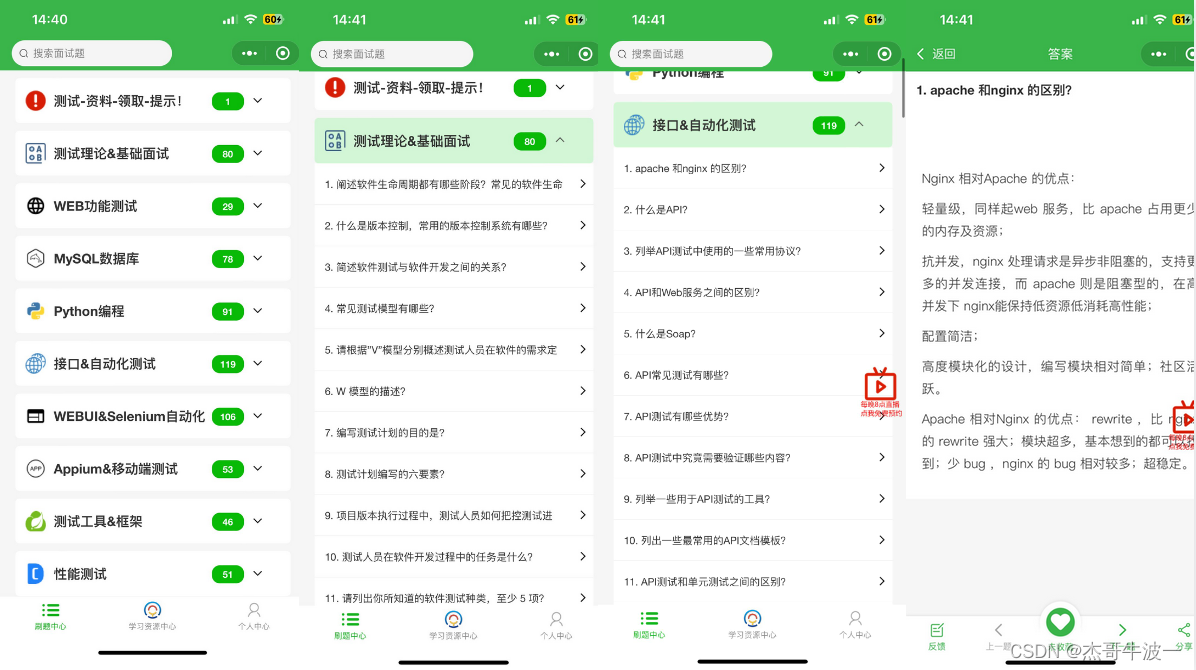
在本篇技术博客中,我们将探讨如何使用Python操作MySQL数据库。我们将首先介绍如何建立连接,然后展示如何执行基本的数据库操作(如创建表、插入数据、查询数据等)。最后,我们将通过一个详细的代码案例来巩固所学内容。
目录
- 简介
- 安装MySQL Connector
- 建立连接
- 创建数据库
- 创建表
- 插入数据
- 查询数据
- 更新数据
- 删除数据
- 详细代码案例
- 总结
1. 简介
MySQL是一种关系型数据库管理系统,广泛应用于各种应用程序和网站。Python提供了多种库来与MySQL数据库进行交互,本文将使用官方推荐的mysql-connector-python库。
2. 安装MySQL Connector
在开始之前,确保已经安装了mysql-connector-python库。如果尚未安装,可以使用以下命令进行安装:
pip install mysql-connector-python
3. 建立连接
为了与MySQL数据库进行交互,我们首先需要建立连接。以下代码展示了如何使用mysql.connector.connect()方法建立连接:
import mysql.connectorcnx = mysql.connector.connect(host="localhost",user="your_username",password="your_password"
)print("Connected to MySQL server!")
cnx.close()
4. 创建数据库
连接到MySQL服务器后,我们可以创建一个新的数据库。以下代码展示了如何使用CREATE DATABASE语句创建一个名为mydb的数据库:
import mysql.connectorcnx = mysql.connector.connect(host="localhost",user="your_username",password="your_password"
)cursor = cnx.cursor()
cursor.execute("CREATE DATABASE mydb")print("Database 'mydb' created!")
cnx.close()
5. 创建表
创建数据库后,我们需要在其中创建表。以下代码展示了如何创建一个名为users的表,并为其添加id、name和email列:
import mysql.connectorcnx = mysql.connector.connect(host="localhost",user="your_username",password="your_password",database="mydb"
)cursor = cnx.cursor()
cursor.execute("""
CREATE TABLE users (id INT AUTO_INCREMENT PRIMARY KEY,name VARCHAR(100),email VARCHAR(100)
)
""")print("Table 'users' created!")
cnx.close()
6. 插入数据
创建表后,我们可以向其中插入数据。以下代码展示了如何向users表插入一条数据:
import mysql.connectorcnx = mysql.connector.connect(host="localhost",user="your_username",password="your_password",database="mydb"
)cursor = cnx.cursor()
sql = "INSERT INTO users (name, email) VALUES (%s, %s)"
val = ("John Doe", "john.doe@example.com")
cursor.execute(sql, val)cnx.commit()print(f"{cursor.rowcount} record(s) inserted!")
cnx.close()
7. 查询数据
我们可以使用SELECT语句从表中查询数据。以下代码展示了如何从users表中查询所有数据:
import mysql.connectorcnx = mysql.connector.connect(host="localhost",user="your_username",password="your_password",database="mydb"
)cursor = cnx.cursor()
cursor.execute("SELECT * FROM users")for row in cursor.fetchall():print(row)cnx.close()
8. 更新数据
要更新表中的数据,我们可以使用UPDATE语句。以下代码展示了如何更新users表中的一条数据:
import mysql.connectorcnx = mysql.connector.connect(host="localhost",user="your_username",password="your_password",database="mydb"
)cursor = cnx.cursor()
sql = "UPDATE users SET email = %s WHERE name = %s"
val = ("john.doe@newexample.com", "John Doe")
cursor.execute(sql, val)cnx.commit()print(f"{cursor.rowcount} record(s) updated!")
cnx.close()
9. 删除数据
要从表中删除数据,我们可以使用DELETE语句。以下代码展示了如何从users表中删除一条数据:
import mysql.connectorcnx = mysql.connector.connect(host="localhost",user="your_username",password="your_password",database="mydb"
)cursor = cnx.cursor()
sql = "DELETE FROM users WHERE name = %s"
val = ("John Doe",)
cursor.execute(sql, val)cnx.commit()print(f"{cursor.rowcount} record(s) deleted!")
cnx.close()
10. 详细代码案例
在本节中,我们将通过一个实际案例来巩固前面所学的内容。我们将创建一个简单的应用程序,该程序可以将用户信息添加到数据库中,并根据需要查询、更新或删除这些信息。
import mysql.connectordef connect_to_db():return mysql.connector.connect(host="localhost",user="your_username",password="your_password",database="mydb")def create_user(name, email):cnx = connect_to_db()cursor = cnx.cursor()sql = "INSERT INTO users (name, email) VALUES (%s, %s)"val = (name, email)cursor.execute(sql, val)cnx.commit()cnx.close()def get_all_users():cnx = connect_to_db()cursor = cnx.cursor()cursor.execute("SELECT * FROM users")result = cursor.fetchall()cnx.close()return resultdef update_user_email(name, new_email):cnx = connect_to_db()cursor = cnx.cursor()sql = "UPDATE users SET email = %s WHERE name = %s"val = (new_email, name)cursor.execute(sql, val)cnx.commit()cnx.close()def delete_user(name):cnx = connect_to_db()cursor = cnx.cursor()sql = "DELETE FROM users WHERE name = %s"val = (name,)cursor.execute(sql, val)cnx.commit()cnx.close()# 添加用户
create_user("Alice", "alice@example.com")
create_user("Bob", "bob@example.com")# 查询所有用户
users = get_all_users()
print("All users:")
for user in users:print(user)# 更新用户邮箱
update_user_email("Alice", "alice@newexample.com")# 查询所有用户
users = get_all_users()
print("All users after update:")
for user in users:print(user)# 删除用户
delete_user("Bob")# 查询所有用户
users = get_all_users()
print("All users after deletion:")
for user in users:print(user)
11. 总结
在本篇博客中,我们学习了如何使用Python操作MySQL数据库。我们讨论了如何建立连接、创建数据库和表、插入数据、查询数据、更新数据以及删除数据。最后,通过一个详细的代码案例来巩固所学知识。
最后,绵薄之力
感谢每一个认真阅读我文章的人,虽然不是什么很值钱的东西,如果你用得到的话可以直接拿走:

这些资料,对于【软件测试】的朋友来说应该是最全面最完整的备战仓库,这个仓库也陪伴上万个测试工程师们走过最艰难的路程,希望也能帮助到你!
软件测试面试小程序
被百万人刷爆的软件测试题库!!!谁用谁知道!!!全网最全面试刷题小程序,手机就可以刷题,地铁上公交上,卷起来!
涵盖以下这些面试题板块:
1、软件测试基础理论 ,2、web,app,接口功能测试 ,3、网络 ,4、数据库 ,5、linux
6、web,app,接口自动化 ,7、性能测试 ,8、编程基础,9、hr面试题 ,10、开放性测试题,11、安全测试,12、计算机基础

获取方式 :
这份文档和视频资料,对于想从事【软件测试】的朋友来说应该是最全面最完整的备战仓库,这个仓库也陪伴我走过了最艰难的路程,希望也能帮助到你!以上均可以分享,关注公众号:一个心态巨好的朋友 扣 ‘1’ 即可自行领取。





